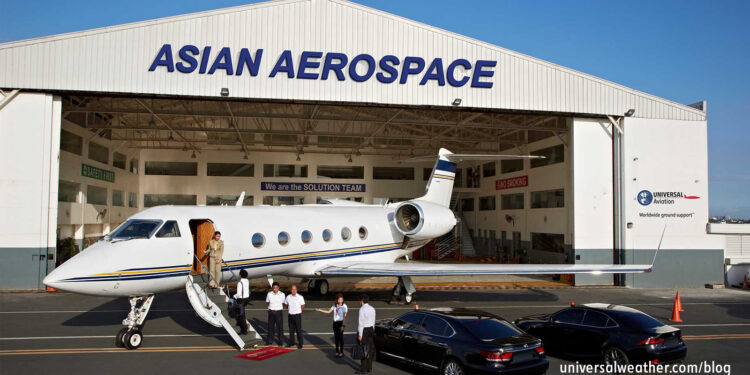Business Aircraft Ops in the Philippines – Top Considerations

This is part one of a two-part article series focusing on operations to the Philippines.
Unique considerations exist for business aircraft operations to the Philippines, and it’s important to plan on sufficient permit lead time. The Philippines comprises over 7,000 islands, and Manila is the most common destination for General Aviation (GA) movements.
The following is an overview of what you need to know:
1. There are few AOEs in the Philippines
Manila (RPLL) is the most popular business destination for the Philippines, and this is a 24-hour Airport of Entry (AOE) with 24-hour Customs, Immigration, and Quarantine (CIQ) availability. Mactan-Cebu (RPVM) is an AOE, but the airport normally operates Monday-Friday, 0800-1700 local. Clark (RPLC) and Davao (RPMD) are also AOEs, but only upon request. You’ll clear CIQ at RPLL at the World Aviation hangar – Delta gate – in the GA area. For RPVM the customs clearance can take up to an hour to complete, and fees for such clearance must be paid planeside in cash unless other arrangements are made in advance. At RPLC the customs officer will collect $350 USD for the entry/exit customs charge. This must be paid in cash by the captain. For RPMD two customs agents must travel from Manila to supervise CIQ clearance with an advance notice of at least 24 hours. For such requests allowances for food, transportation, and hotel expenses for the customs agents will be charged to the operator. Most airports in the Philippines are domestic-only, and it’s always best to check on available aircraft services prior to operation. It’s recommended that you carry a tow bar whenever traveling to the Philippines – especially for operations to outlying airports.
2. Always use a ground handler
Due to language barriers and assorted airport operating challenges, it’s always best to use a local ground handler for all landings in the Philippines. Your ground handler will assist with arranging fuel and all required services, paying all fees, and escorting crew members/passengers through CIQ process. Your handler will advise in advance of any local procedures/requirements. Universal Aviation has begun operating a newly renovated fixed-base operator at RPLL with Asian Aerospace Corporation, with offices also at RPLC and RPVM.
3. Philippine landing and overflight permits are needed
Landing and overflight permits are mandatory for all private non-revenue and charter (non-scheduled commercial) operations. Plan on a minimum of seven business days’ lead time for charter and private non-revenue landing permits. Currently, the Civil Aviation Authority of the Philippines (CAAP) only approves short-notice permit requests for air ambulance operations and overflight applications – on a case-by-case basis. Note that for all landing permit requests – with exception of tech stops – a local business contact must be provided.
4. Be aware of permit validity and documentation requirements
For a private non-revenue Philippine landing permit, it’s necessary to provide certificates of airworthiness and registration, copies of pilot licenses and current medicals for pilot in command and first officer, a color side-view image of the aircraft (in JPEG format) showing the tail number, and a letter of certification stating that the flight is private non-revenue. For charter landing permits, the same documentation is needed as with private non-revenue landing permits, but you must also provide the Air Operator’s Certificate and worldwide insurance document. Note that Philippine permits are valid for 72 hours. Permit revisions require one to three days to process, depending on availability of an authorized CAAP official to sign the revised permit. Normal CAAP operating hours are 0800-1700 local with “beyond business operating hours” of 1700-0800 local. While CAAP closes for public holidays, there are always CAAP personnel on duty, available 24/7 throughout the year, to process permit applications/revisions.
5. Review permit revision requirements
For earlier operations outside the 72-hour permit window, send a revised permit request, and a new permit number may be issued. For later operations or crew/passenger change, the permit number remains the same, but you’ll need to send a notification. For origin/destination or aircraft registration changes, revision requests are necessary, and a new permit number may be issued. In the case of routing changes, you’ll send a revised permit request, and a new permit number may be issued. Note that no notification is required for any route changes so long as origin/destination remain the same.
6. Be sure to cancel unneeded permits
If an obtained permit is not needed, it’s important to take the proper steps to cancel the permit. When a permit is issued, navigation fees are collected and are non-refundable. However, if a notice is filed with CAAP to cancel a permit payment for the cancelled flight, it will be kept on record – for one month – and may be used to offset an operator’s next flight operation to the Philippines.
7. It’s best to confirm fuel uplifts in advance
While RPLL has adequate aviation fuel availability, there are many airports in the Philippines that require prior notice to arrange fueling.
8. Plan hotel accommodations and local transport well in advance
A selection of 4-star crew accommodations is available in Manila and at major tourist resort destinations. Hotel options are considerably more limited at outlying areas, so it’s best to check in advance. For local transport it’s recommended to book prepaid transport (car with driver) and to avoid public transportation. Rental vehicles should only be used if crew/passengers are familiar with the area.
Conclusion
To avoid operating complications in this part of the world, it’s best to double-check all permit and permit revision requirements well in advance of operation.
Later, we’ll discuss CIQ and security for your trip to the Philippines.
Questions?
If you have any questions about this article or would like assistance planning your next trip to the Philippines, contact me at davidbutler@univ-wea.com.



